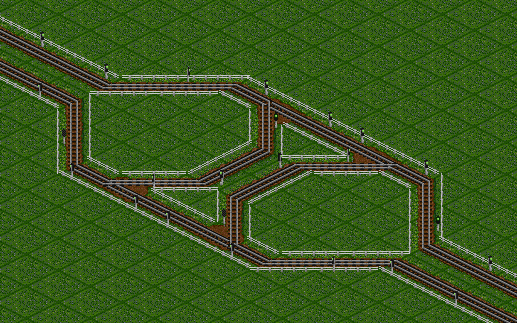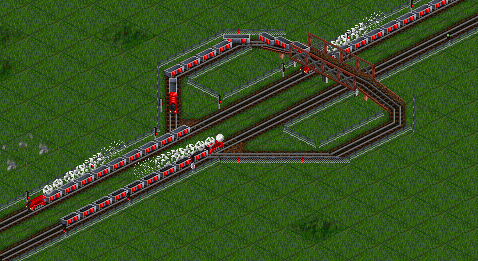-
Basic 3-Way
-
Line Merge
-
Half Cloverleaf
-
Half Spaghetti
-
Compact 3-Way
-
Compact 3-Way B-M Junction
-
Ultimate 3-way
-
Half Transmogrified
-
Braided Junction
-
Basic 4-Way
-
Roundabout
-
Cloverleaf
-
Spaghetti
-
Star
-
Complex Star
-
Branch-Merge
-
Tetrathorp
-
High Speed 4-Way Fly-over∕under
-
Pre-Signaled Roundabout
-
Advanced Roundabout
-
Right-of-way Roundabout
-
Improved Roundabout
-
Transmogrified
-
Tightlong
-
Deepblue2k8 4-way Junction
-
Multi-way/multi-track cloverleaves
-
Dual Tetrathorp
-
Dual Transmogrified
-
Dual Branch-Merge
-
Quad Branch-Merge
-
Quad Tetrathorp
-
6-tuple Branch-Merge
-
8-Way Star
-
High Speed 4-way
-
Building depots
-
Dual tunnels
-
Sideline U Turn
-
Right-of-way Lane Change
-
Priority Merge
Contents |
Inline loop
This little junction is good for low density networks with trains that are short enough to fit inside the loop or so heavy that they cannot scale even a single slope.
Pros:
- Cheap & small
- No sharp turns
Cons:
- Longer trains can block the mainline when in the turning lane
Flyover loop
With the help of a bridge (or a tunnel) the U-turn loop can be made as wide as needed, without requiring any modifications to the mainline.
Design tips
- Make sure that the turning spur is long enough that the longest train can fit completely inside it. Otherwise a train that took the turn will block the trains that go straight.
- Make sure to place a path signal in front of the track split. Otherwise a turning train will block the straight direction even if it doesn't occupy the actual track.
- There is no need for excessively wide turns, because the train that took the turn is likely to stop anyway when merging into the mainline.
- A bridge works slightly better than a tunnel, because its downward slope is located closer to the exit, and thus it will speed up the exiting train a bit longer.
- As with any sideline merge, it is a good idea to install a priority.









